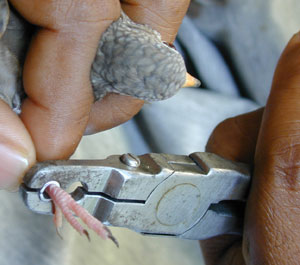Bird banding  is one of the most important techniques for studying all aspects of life history that are important to the survival of Jamaica's resident and migrant birds, including:
is one of the most important techniques for studying all aspects of life history that are important to the survival of Jamaica's resident and migrant birds, including:
Birds are captured and marked with a uniquely numbered band placed on the leg. Banders record where and when each bird is banded, how old it is, what sex it is, and any other information relevant to the condition of the bird. When banded birds are recaptured, either by the original bander or by someone else, we can learn about the distribution, movement, habitat usage, life-span and population trends of species. Such information increases our knowledge and understanding of birds and their habitat requirements and assists in their management and protection. When banding efforts are in a co-ordinated network of nations and regions, such as is overseen by the USGS Bird Banding Laboratory for Neotropical Migrants, we have a powerful tool for bird conservation beyond national boundaries.
In 2002, WRC established a permanent bird banding station on the organic farm of Windsor Great House. This core station was followed-up in 2003 with the establishment of two additional sites to expand our monitoring to regenerating forest habitat (see Site Map & Description). We currently operate nets at each site for two days each month, 6 hours each day in the morning. The birds learn the positions of the nets very quickly so there's little point in running nets a third day! Click here for our schedule. To-date, we have banded over two thousand birds. Please visit our on-line database for more details.
The establishment of our banding station was made possible through the support of the National Fish and Wildlife Foundation (a two-year grant which concluded in April 2004 - see final report) and The Nature Conservancy-Jamaica (a one-year grant concluded in October 2003). Thanks to a new, two-year grant from the Environmental Foundation of Jamaica and a three-year UNEP grant administered by BirdLife International as part of the Important Bird Areas (IBA) Programme, we are able to extend our efforts in time and space and strengthen our community outreach and educational materials.
We owe an enormous amount of gratitude to Bird Studies Canada, Klamath Bird Observatory, and Catherine Levy when she was president of BirdLife Jamaica for conducting training workshops, supporting our participation in Latin American Training at Long Point Bird Observatory (BSC), and for providing comments to improve our operating procedures and data collection. We continue to maintain close working relationships with these organizations and individuals as well as looking to collaborate with others who support this work. For example, in fall 2003 / spring 2004, WRC participated in the Institute for Bird Populations' Monitoreo de Sobrevivencia Invernal (MoSI) neotropical migrant bird monitoring programme.
If you would like to receive training (see details of our first workshop) or participate regularly in the banding, please for arrangements. We also welcome all comments and queries from researchers, particularly in relation to the data we are collecting in our physical assessments of the birds.